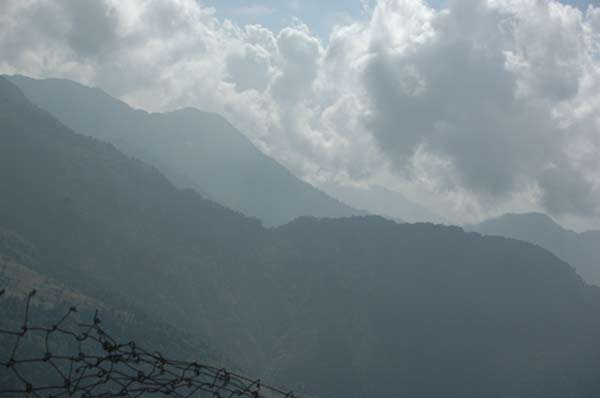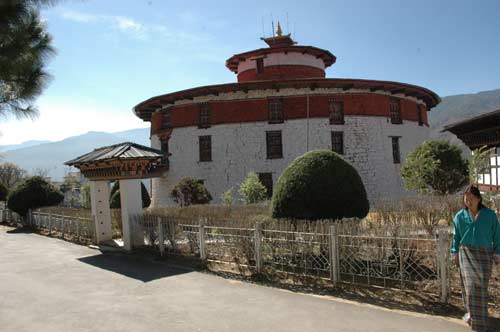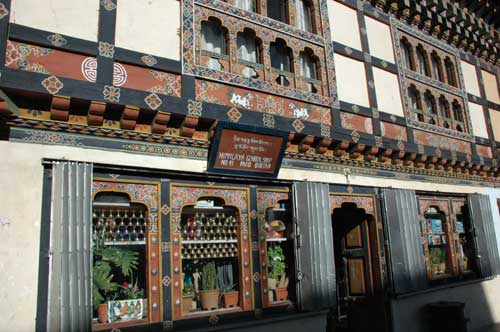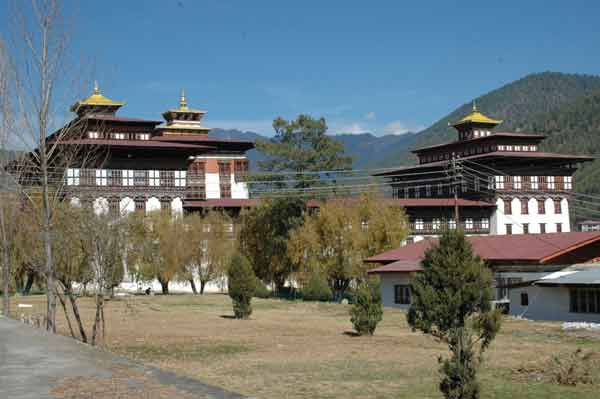SWEDISH SOUTH ASIAN STUDIES NETWORK
Bhutan impressions, from a journey Phuentsholing – Thimphu, Sunday 27 November

This is tropical green – all kinds of crops can be grown, rice,
fruits and vegetables, but only on miniscule plots on terraces of the
mountain slopes and for family use. Women inherit all property, including
land, so no male land grabbing here! Little is exported – we know
of only apples. But the forest is rich and if you can log it and cart
it somewhere, it is certainly worth it. But that is a royal prerogative,
all forest belong to the state. The real asset in these mountains are
the streams, rivers and waterfalls – the most important source of
income to the government and those sharing in state incomes is export
of hydro-electric power to India.
Houses have an appearance like in many mountain countries, like Switzerland
or Austria, with flatly sloping roofs but there is a distinct Himalayan
touch with all the woodwork decorations. There must be a lot of very good
carpenters around.
Not all houses are like that. We find rows of shacks belonging to, it
is said, those Llotshampa Nepalese people who are still working and living
here.
 |
| National Museum in Paro |
The king guides the country
With a population of about 7 lakhs this is of course a very small humanity
to govern for the Bhutanese King, the fourth in line since the creation
of an all-Bhutan kingdom in 1907. He guards the Buddhist tradition of
most Bhutanese and he now guides the country into a negotiated modernity
that is rather unique in South Asia, not to speak of the rest of the world.
In the early 1990’s the king declared a Bhutanese code of conduct,
the so-called Driglam namzha (more
information). While at work, in offices or factories, citizens should
wear a national dress, which we now see on many people around, increasingly
so as we approach the capital Thimphu. It is not really a uniform, however,
and we see many different patterns and colours of the dress.
Second, all should speak the national language Dzongkha. It was supported
by most people and seems well anchored in the Bhutanese ethnos. The Lhotshampa
minority though, of Nepalese origin but since generations in Bhutan, objected
and mobilised against it with some violence in the end. As a result, about
a lakh of these people are now staying in refugee camps on the other side
of the border to Nepal.
The king is also the guardian of the Himalayan Buddhism practiced here,
but with a ‘division of labour’ with the Chief Abbot of Lama,
who is the spiritual head and with the same status as the king. All inhabitants
are not Buddhists, but most are however divided by tribal distinctions
and languages. A decisive minority is also Hindu, whether hailing from
Nepal or parts of northern India.

New constitution is coming
A new constitution is in the making, allowing for a constitutional democracy
and freedom of religion. Negotiations are going on about the return of
the refugees in camps in Nepal.
We meet a lorry representing Coca-Cola Bhutan. We see people with modern
consumer goods all around but mixing it with a distinct everyday traditional
Buddhist culture. Internet came late here as did TV. Both of these modern
media were introduced in 1999 and there is now a national channel with
English subtitles. However, satellite TV is also there and the Bhutanese
can take the whole world into their drawing rooms.
Tourism is still much limited. It is more or less restricted to an up
market exclusive tourist inflow via tour groups, and each tourist must
pay about 220 dollars a day, all inclusive.
The state of Bhutan owns all rivers, forests, and mineral resources and
the environment is protected by strict rules about logging prescribing
that at least 60 per cent of the Bhutan territory should be covered with
forest. As we approach the central part of the kingdom, we can see that
the higher areas, where pine trees grow, are less fully covered with forests,
and we understand that this may be a necessary protective measure. However,
nothing like the devastating deforestation that has taken place in other
parts of the Himalaya can be seen here.
Tobacco is banned, and smugglers from India have a hard time, since the
Bhutan police and army is now well equipped to deal with troublemakers
after its build up to successfully fight Indian tribal extremist groups
hiding within Bhutan borders in the 1990s.
 |
| The centre of power in Bhutan, the dzong in Thimphu housing the offices of the King as well as of the Chief Abbot (Je Khenpo) who is chosen from among the most learned lamas of the country. He enjoys an equal rank with the King. |
How come such an autonomous approach to national borders, culture and economy has been possible in South Asia on the border to China? Can it be preserved in this era of globalisation?
India and China seem to have held each other at bay in this case, neither allowing the other any interference. Bhutan, has also not had any decisive internal challenge to its system of rule, like that in Sikkim, which simply couldn’t handle Nepalese uprisings in the seventies and, therefore, asked for Indian help. Sikkim was immediately annexed by India in 1975, and China couldn’t really stop it.
More interestingly though. Has Bhutan found a formula also for preserving difference in a world of equalising global forces of commerce, culture and politics? It really remains to be seen, but should be worth a close follow up by all those people who value cultural roots and a sound environment.
SASNET - Swedish South Asian Studies Network/Lund
University
Address: Scheelevägen 15 D, SE-223 70 Lund, Sweden
Phone: +46 46 222 73 40
Webmaster: Lars Eklund
Last updated
2006-02-13
